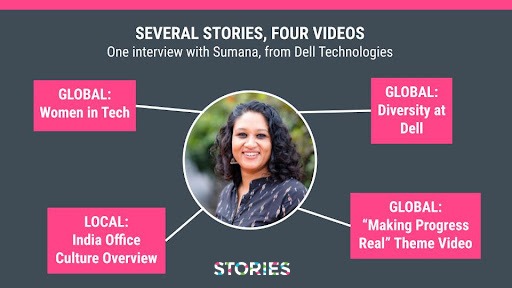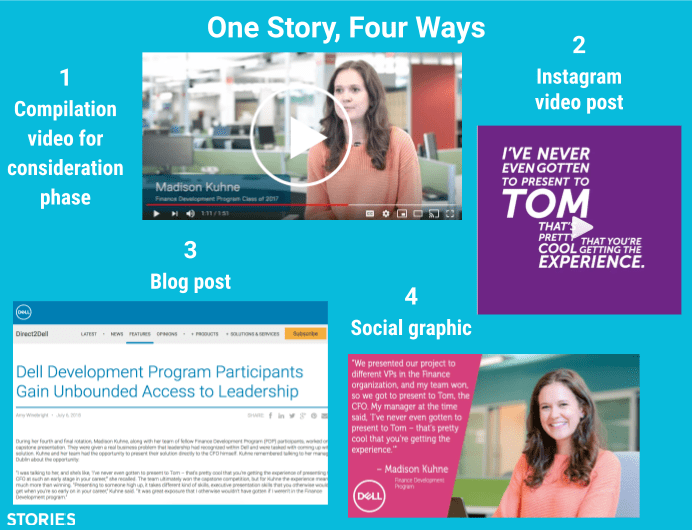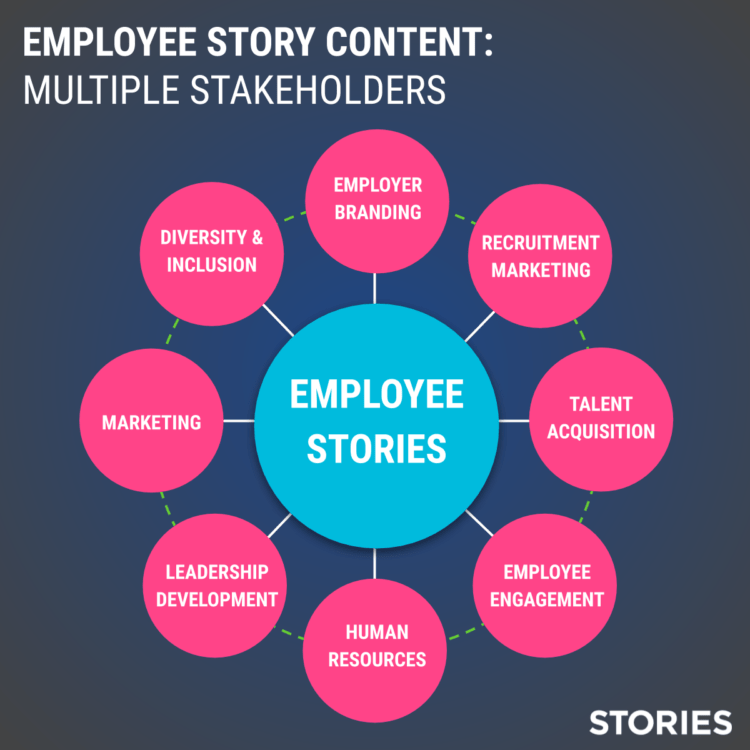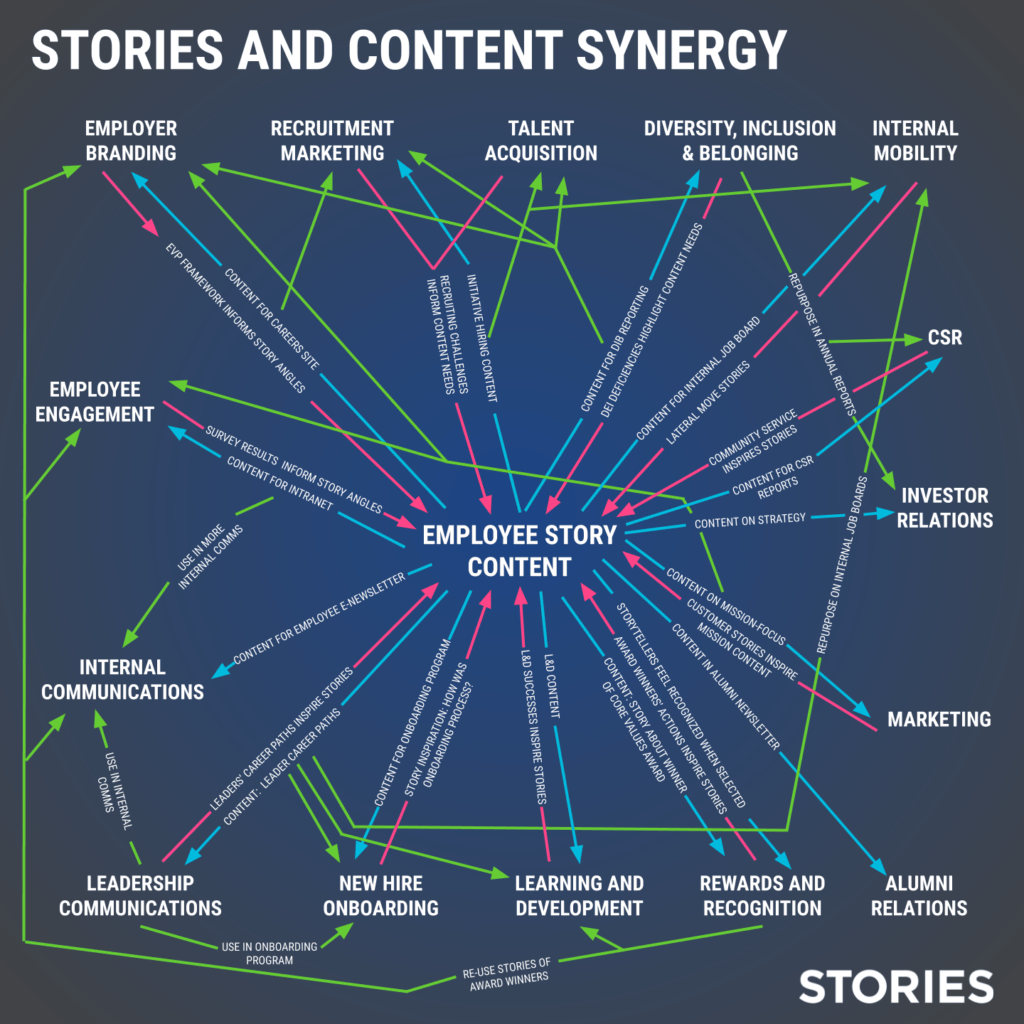Always-On Recruitment Marketing Through Stories
Employee story content is the best recruitment marketing content, period, and should be part of your always-on recruitment marketing content strategy.
Stories from team members are not a once-in-a-while project, or idea for an individual campaign. They’re not a “nice to have” within your culture communications. They’re a must have, all the time.
Companies require a steady stream of stories told by people experiencing the culture, for several data-backed reasons.
- Candidates consume, on average, 18 different messages about a company before actually submitting their application.*
- Currently, over 70 percent of the workforce is passive talent, so one-off campaigns aimed at active job seekers will miss their mark.**
- Overwhelming data shows employees are the voices candidates and fellow team members trust the most.
The answer to attracting candidates and connecting employees to their culture is the continual sharing of stories of your company culture: an always-on recruitment marketing content strategy.
Why stories must be always-on
Always-on marketing is the content marketing strategy of continually publishing content that speaks to your core audiences. It’s the opposite of taking a campaign approach to marketing, such as sharing content at certain times of year or surrounding a special announcement. Additionally, always-on marketing has a constant flow of messaging. It’s not the delivery of content when an organization or team “can get to it” or finds time for it. (You must always have the time for it.)
Brand awareness of your company culture is only possible through a consistent delivery of messages that hit home.

An employee story approach
The good news: an employee story approach is an efficient path to accessing a constant flow of content. You can develop a continuous story of your culture (cue The Neverending Story theme music) with an always-on story strategy. Here are our eight best tips for setting it up.
1. Mine your analytics for insight into stories that receive great engagement …
What sections of your careers site receive the most traffic? What are your Life At blog’s most popular posts? Which social content gets the most engagement? Use this data to determine which stories are resonating with your audiences. Then, plan to capture more and current iterations of those stories
2. … and for insight into areas where your content is lacking
A deep dive into your data will also show you where your channels are not receiving traffic or engagement, too. These lower levels of visitors to certain pages or engagement on social posts could reveal that your content in these areas is outdated or uncompelling. Therefore, update these areas with low engagement with content grounded in the real, recent stories of employees.
3. Look at your most pressing goals and seek the stories
We understand that you have a lot of KPIs and goals right now. It’s stressful. You could be focused on hiring more women in tech, while also working to increase awareness of your company’s DEI efforts, while supporting internal communications goals, too.
So, let’s look at these multiple business outcomes that need content with a glass half-full point of view. A long list of KPIs means you can develop a big list of employee interviews that will yield stories to fill your content calendar.
4. Conduct facilitated interviews for maximum stories
When you run a great interview process, you get lots of great stories. When you rely on employee generated solutions, you’ll get just one … and it’s more likely to be a testimonial and not a true story that connects with the audience.
Facilitated interview processes where employees feel safe, celebrated and heard uncover a wealth of stories. Each person can share several experiences, all of which you can use in many ways across your culture content. And, each story that you gather becomes an asset that can produce multiple content pieces and yield multiple returns.

5. Reuse and repurpose stories that speak to your culture
Unlike campaign-based marketing, in which the content is one and done, always-on strategies find new uses for existing content. Take inventory of the stories that exist in your already-created content, and think of new channels and audiences for those stories.
For example, we captured a story from Madison, a member of Dell Technologies’ rotational program. The story can be used in a Life At blog post, in a long-form video for LinkedIn and YouTube, as an animated graphic Instagram post, and as a graphic social ad.

6. Ask for and share the content love
You can reuse content other departments in your company are making to serve their audiences. Even though they may be serving different audiences than yours, the great news is that everyone is interested in what your company is doing to keep employees engaged, to create a more inclusive environment, or what your values are like in action.

Stories are content that can be shared by all parts of an organization. They can be repurposed in so many ways. Stories content may originate in the needs of one part of the company, but the results can inform and inspire stories which are useful to other departments. In order to illustrate this sharing of stories, Stories Inc. co-founder Scott developed this infographic, inspired by a sketch by Walt Disney.

7. Build a content marketing calendar for the year
Tools for building your content marketing calendar are essential for an always-on story strategy. So, we create them for culture communicators every year! Our 2022 Recruitment Marketing Content Planner is a worksheet and guide to help you map out the stories you need for continuous messaging across your channels and the different content types. It includes resources for planning content in verticals like values and purpose, DEI, hybrid and remote options, global culture and more. And, if DEI content is a important area of focus for your channels, we have a special DEI Content Planning Worksheet and Guide, too.
You should also use the literal calendar to instruct your editorial calendar: share employee stories around cultural celebrations and important dates. Our 2022 Diversity and Inclusion Calendar Download will help you plan the sharing of timely stories and be a part of key cultural conversations. And, these stories also serve as important inclusion content no matter the day of the year.
8. Assess your resources and delegate where needed
Once you map out all the stories you need for your always-on content strategy, if you’re feeling overwhelmed, you don’t have to do it alone.
Always-on strategies need stories, optimized per channel, and lots of them.
Our experts at Stories Inc. can serve as extensions of your team, and can handle the story capturing and content creation for you. Delivering content libraries of stories, optimized by channel, is our specialty.
Contact us to get started
Sources:
* Career Builder, Exclusive Insights from the 2017 Candidate Experience Survey.
** LinkedIn, The Ultimate List of Hiring Statistics.

